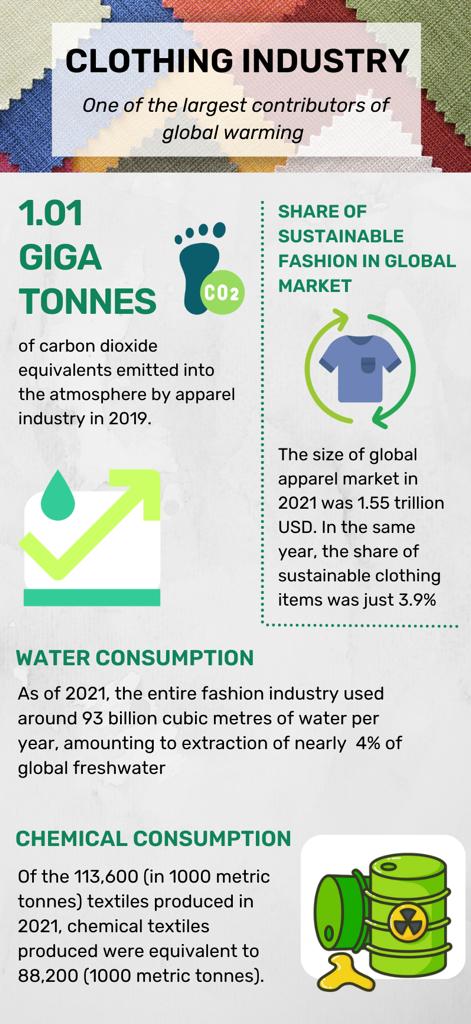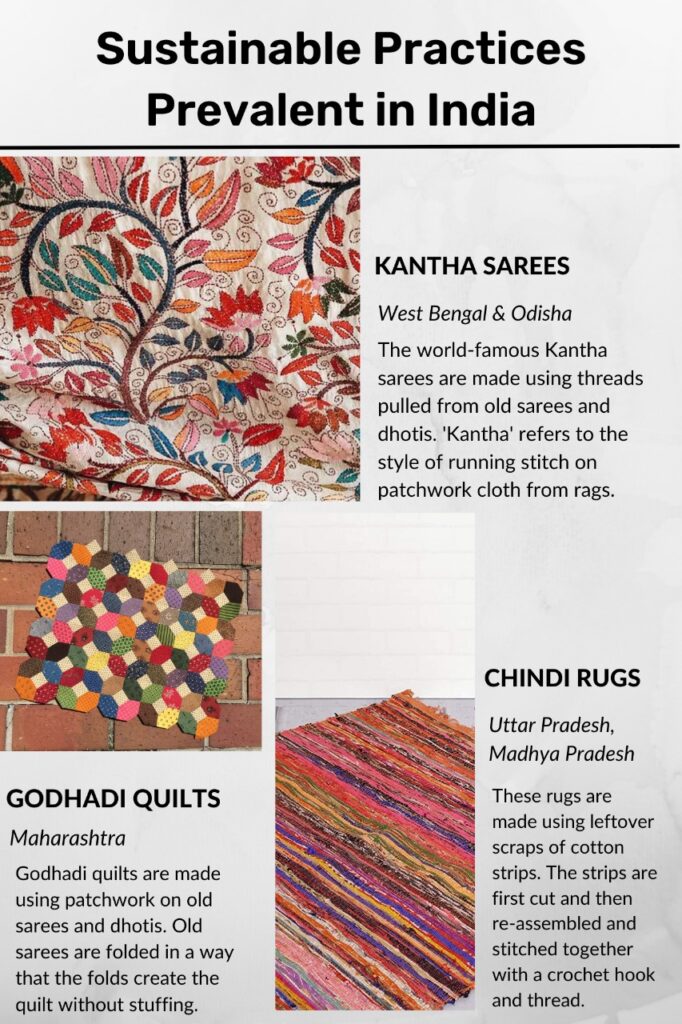Crafting a sustainable future for the Indian textile industry, one thread at a time
With growing concerns about the negative externalities posed by the garment sector on the environment, it has become imperative to bring about a green revolution in the fashion industry – one of the largest polluters in the world.
The recent years have witnessed a massive transformation in people’s mindsets towards the environment and its sustainable consumption. Increasing instances of devastating climate-related disasters like wildlifes, frequent flooding, extreme droughts, to name a few, have shifted the world’s attention toward ramping up environmental conservation efforts across the globe. The consumption habits and preferences of individuals have also seen a drastic change. Among the many conscious habits adopted, people have started realising the detrimental impact of fast-fashion on the environment which has stimulated demand for cheap and low-quality goods resulting in over production without proper disposal. As a result, the concept of sustainable fashion has garnered immense popularity.
The sustainable fashion industry originally gained momentum in rebellion to the rising capitalism in America in the 1950s. Since then, many international efforts have been made to give impetus to this sector. In 1992, for the first time, the United Nations Conference on Environment and Development, also known as Rio Earth Summit, helped spread awareness about the pressing problems posed by the textile industry, one of the largest polluters in the world. To boost production of sustainable textiles, The Global Organic Textiles Standard was established in 2006 as an internationally-recognised textile processing standard which to incentive manufacturers to make products containing a majority of organic natural fibers and to ensure that all their processes like packaging, labeling, trading, and distribution do not pose any threat to the environment.
The Paris Agreement of 2015, which set out to limit global warming to less than 2 degrees above pre-industrial levels, also shifted the focus to the textile and fashion industry at large. In 2018, the United Nations Framework Convention on Climate Change (UNFCCC) forged a Fashion Industry Charter for Climate Action as an industry-wide commitment to support the goals of the Paris Agreement and Goal 12 under Sustainable Development Goals of responsible consumption and production. These interventions have prompted the world to look more favorably towards alternatives like sustainable textiles and fashion.
“Sustainable fashion” – What does it really mean?
The concept of sustainable fashion intends to overturn mass-manufacturing and overconsumption of cheaply made clothes and minimise the otherwise enormous carbon footprint of the water and chemical-intensive textile industry.
Sustainable fashion industry rests on the idea of recycling waste by using scraps and trims to produce good quality clothes and increasing reliance on natural fibers like jute, hemp, flax etc. Beyond environmental aspects, the sector includes within its ambit practices that promote usage of naturally-made dyes, minimal usage of synthetic raw materials in production, increased consumption of handcrafted artisanal products, ethical employment, hygienic work places and adoption of eco-friendly practices to significantly drive down the carbon footprint of the clothing industry as a whole.

A glance at the Indian landscape:
The Indian textile industry has a rich legacy of more than 5000 years old. Since the beginning, it has portrayed an exemplary combination of artisanal skills and managing with little resources. During the era of Indus Valley Civilisation, textiles were manufactured in India from animal hair, wool, cotton and silk. Over the centuries, many dynasties contributed to the growth of the Indian textile sector. Silk manufactured during the reign of the Mauryan dynasty became a highly priced commodity. The rise of Gangetic Plains as an important center of textile production led to an increase in production of high-quality and low-cost cotton that was then spun, dyed and weaved to manufacture highly-sought after textiles. These textiles contributed to nearly 25% of imports by England during colonial years for further selling in the international markets.
Post independence, the Indian garment industry went through a number of changes. After the introduction of economic liberalization reforms in 1991, the country’s clothing industry has progressed manyfolds. Irrespective of its growth, the practices of recycling and upcycling of handmade clothes continue to remain an integral part of India’s rich heritage.
Over the years, the Indian apparel industry has diversified into production of traditional handlooms, handicrafts, wool and silk products. Today, it is one of the most vibrant industries, estimated to be worth more than $209 billion by 2029. Asia accounts for almost 60% of global exports of garments, textiles and footwear with a large proportion of manufactured products coming from China and India.

Propelling the adoption of sustainable fashion
While our upcycled textiles and handlooms are a glorifying story of sustainability, a lot has to be done to maintain India’s standing for housing a sustainable and eco-friendly textiles industry. In a bid to do so, the Government of India began furthering the cause of sustainable fashion and textile production and in 2000, the National Textile Policy was passed which provided strong legal protections to weaving and milling industries against importing fibers from outside of India.
In 2005, Scheme for Integrated Textile Parks was formulated with the aim to build an industry that had world-class infrastructure fitted with latest innovations to produce best quality fabric with least carbon emissions. Three years later, India implemented the policy of Sustainable Textiles for Sustainable Development under the European Commission’s SWITCH-Asia Programme which lasted till 2014. The project promoted production and consumption of eco-friendly textiles with an emphasis on improving the working and living conditions of artisans through grass-root level interventions like skill training, dissemination and identification of key problem areas.
In 2019, Project SU.RE was launched with a 5-point agenda of developing a holistic understanding of harm posed by the garment industry to the environment, formulating a sustainable sourcing policy based on eco-friendly raw materials, spreading awareness of sustainability initiatives and practices to bring about a significant shift towards sustainable fashion and textiles.
Recently, the government has also launched SAMARTH (Scheme for Capacity Building in the Textile Sector) with the purpose of upskilling the artisans and nature fibers manufacturers so that they are able to produce the highest quality of sustainable fabrics. Khadi and Village Industries Commission has also been doing a great job at promoting an eco-friendly approach in the Indian textiles industry.
Way forward:
It cannot be ignored that our textiles industry still produces a massive amount of carbon emissions because of its heavy reliance on hard coal and natural gas for electricity. The fast-fashion clothing brands in the West are creating a huge carbon leakage by offsetting carbon emissions in developing countries like ours by driving up our production intensity to meet the growing global demand for textiles.
There is a pressing need to ensure that moving forward, the sector remains sustainable in its conscious approach towards fabrics. To do so, we need to lay greater emphasis on employing energy efficient measures across production facilities so that they can lower their carbon footprint and automatically reduce the burden on the environment. Another effective solution is to harness electricity from renewable resources so that we are less dependent on burning of harmful fossil fuels for energy. Higher support needs to be extended to impart relevant skill training to artisans and weavers so that they are able to produce goods of competitive quality and enhance the sustainability of textile production in the country.
References:
https://www.4tify.co/blog/a-brief-history-in-sustainable-fashion-milestones#:~:text=Sustainable%20fashion%20was%20first%20introduced,dominated%20America%20from%20the%201950s.
https://www.panaprium.com/blogs/i/sustainable-fashion-start
https://www.solenerauturier.com/blog/history-ethical-fashion
https://www.ilo.org/legacy/english/intserv/working-papers/wp053/index.html#:~:text=The%20textile%20and%20garment%20sector%20accounts%20for%20a%20significant%20proportion,in%20carbon%20emissions%20per%20year.
https://pib.gov.in/PressReleasePage.aspx?PRID=1582685
https://consciouscarma.com/economy/is-sustainability-the-future-of-indian-textiles/